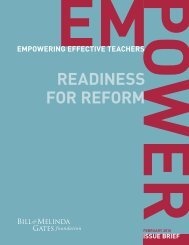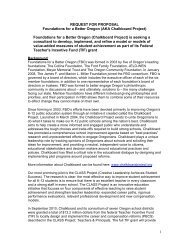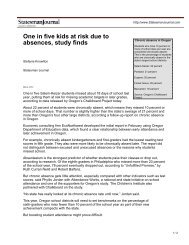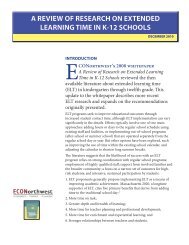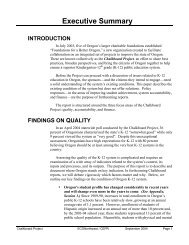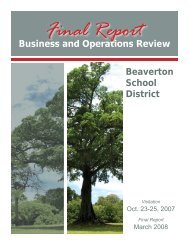Tapping the Potential - Alliance for Excellent Education
Tapping the Potential - Alliance for Excellent Education
Tapping the Potential - Alliance for Excellent Education
You also want an ePaper? Increase the reach of your titles
YUMPU automatically turns print PDFs into web optimized ePapers that Google loves.
TA P P I N G T H E P O T E N T I A L : R E TA I N I N G A N D D E V E L O P I N G H I G H - Q U A L I T Y N E W T E A C H E R SMastery Test (CMT) and <strong>the</strong> Connecticut Academic Per<strong>for</strong>mance Test (CAPT). Forexample, <strong>the</strong> science portfolio requires teachers to demonstrate how <strong>the</strong>y develop students’content knowledge, inquiry, and application of science knowledge as assessedon <strong>the</strong> tenth-grade CAPT. The elementary education portfolio requires teachers todemonstrate how <strong>the</strong>y develop understandings of important literacy and numeracyconcepts assessed in <strong>the</strong> CMT language arts and ma<strong>the</strong>matics assessment.BEST Program seminars, mentor training, and portfolio assessor training focus onunderstanding <strong>the</strong> elements of effective instruction as represented by <strong>the</strong> ConnecticutCommon Core of Teaching (CCT). The CCT competencies place an emphasis onteacher content knowledge, <strong>the</strong> teaching of a specific discipline, and <strong>the</strong> impact ofteaching on student learning.Adequate and Stable FundingSince <strong>the</strong> inception of BEST in 1989, state funding has dramatically changedbecause of state budget shortfalls. Funding <strong>for</strong> <strong>the</strong> program declined from $10 millionin 1991 to $3 million in 1992. The state provided only modest increases over <strong>the</strong> nextdecade, despite larger numbers of teachers participating in <strong>the</strong> program.Consequently, funding <strong>for</strong> BEST is significantly lower in less-affluent districts than inaffluent ones. BEST statutes currently prohibit mandatory collective bargaining overprovisions of <strong>the</strong> BEST Program; however, an increasing number of districts have used<strong>the</strong> permissive provisions of <strong>the</strong> law to negotiate mentor stipends or provisions <strong>for</strong>release time.The state and local districts share <strong>the</strong> costs of BEST, which can be broken downas follows:State shareDirect costs (program administration, training ofmentors and portfolio scorers, beginning teacherseminars and workshops, scoring of portfolios) $600/teacherIndirect costs (state staffing <strong>for</strong> programadministration, development and program evaluation) $160/teacherSubtotal state share$760/teacherDistrict share (local or federal Title II funding)Beginning teacher professional developmentRelease time (cost of substitutes)Mentor stipends(payment at discretion of local district)Subtotal district shareTotal cost$500/teacher$300/teacher$100–2,000/teacher$900–2,800/teacher$1,660–3,560/teacherEffectivenessQuantitative Benefits of BEST• Reduced attrition in <strong>the</strong> early years. A recent study of beginning teacher attrition indicatesthat approximately 6–7 percent leave <strong>the</strong> profession in Connecticut annuallyversus average national estimates of 10 percent or higher. 102 When factoring in a33



